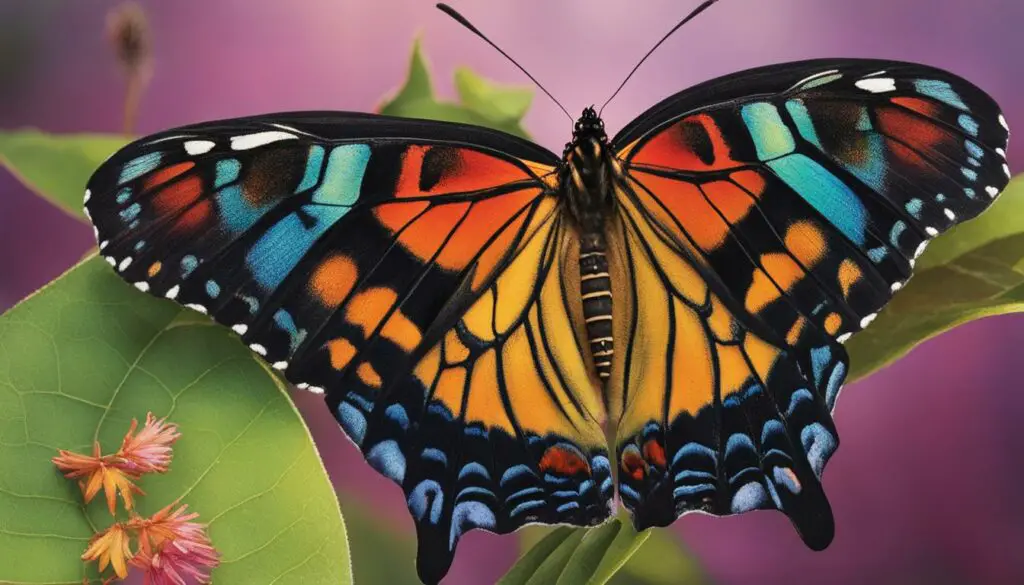As a child, I was always fascinated by the incredible journey of a caterpillar transforming into a beautiful butterfly. The process of metamorphosis, where a lowly caterpillar undergoes a complete transformation to become a graceful butterfly, is a true marvel of nature.
This journey begins with a tiny caterpillar hatching from an egg and embarking on a remarkable adventure of growth and change. Through several stages of development, the caterpillar sheds its skin, grows, and eventually forms a cocoon or chrysalis. Inside this protective casing, a miraculous transformation takes place, turning the once crawling caterpillar into a magnificent flying creature.
Inside the chrysalis, the caterpillar undergoes an intricate process of self-digestion. Certain cells known as imaginal discs survive this digestion and use the rich nutrient soup to fuel rapid cell division and develop into the adult body parts of the butterfly. Wings, antennae, legs, and other intricate features begin to take shape, transforming the caterpillar into a magnificent winged creature capable of flight.
This journey of metamorphosis showcases the beauty and resilience of nature. It serves as a reminder of the transformative power within each of us and the potential for growth and change that exists in our lives.
Key Takeaways:
- The transformation from caterpillar to butterfly is a remarkable process of metamorphosis.
- It involves stages of growth, molting, and the formation of a cocoon or chrysalis.
- Inside the chrysalis, imaginal discs use the nutrient-rich soup to develop into the adult body parts of the butterfly.
- Metamorphosis symbolizes the potential for growth and change in our own lives.
- Embracing transformation allows us to discover our true potential and embrace our unique beauty.
The Life Cycle of a Butterfly
A butterfly goes through three primary stages of development: egg, larva (caterpillar), and pupa (chrysalis). The female butterfly lays eggs on leaves, and once hatched, the caterpillar emerges. The caterpillar spends its time eating and growing, shedding its skin during molting. When fully grown, it enters the pupal stage, forming a chrysalis or cocoon. Inside the chrysalis, the caterpillar undergoes metamorphosis, completely transforming its body into a butterfly. Eventually, the fully developed butterfly emerges from the chrysalis.
The life cycle of a butterfly is a remarkable journey of transformation and growth. Each stage serves a specific purpose, contributing to the eventual emergence of a beautiful and delicate butterfly. From the moment the egg is laid, the process begins, and the caterpillar hatches, ready to consume food and grow. The caterpillar molts several times, shedding its old exoskeleton to accommodate its increasing size.
Once the caterpillar has reached its full size, it enters the pupal stage. This is a period of stillness and internal transformation. Inside the chrysalis, the caterpillar’s body undergoes a complete overhaul, breaking down its old tissues and forming new structures that will eventually become the wings, antennae, and other features of the adult butterfly. It is a process of extreme change and growth, resulting in the emergence of a fully formed butterfly ready to take flight and continue the cycle of life.
| Stage | Description |
|---|---|
| Egg | The female butterfly lays tiny eggs on leaves, typically close to the plant on which the caterpillar will feed. |
| Larva (Caterpillar) | The caterpillar emerges from the egg and begins to eat and grow. It sheds its skin multiple times during this stage. |
| Pupa (Chrysalis) | The fully grown caterpillar forms a chrysalis or cocoon around itself. Inside the chrysalis, its body undergoes metamorphosis. |
| Adult Butterfly | The fully developed butterfly emerges from the chrysalis and begins its life as an adult. It will mate, lay eggs, and continue the life cycle. |
Caterpillar to Butterfly Transformation: The Intricate Process Explained
Have you ever wondered how a caterpillar transforms into a beautiful butterfly? The process of this metamorphosis is truly fascinating. Inside the chrysalis, the caterpillar undergoes a remarkable transformation, completely changing its form and structure. But how does this magical change occur?
As the caterpillar enters the chrysalis stage, it releases enzymes that break down its body into a soupy substance. At the same time, certain cells known as imaginal discs survive this digestion process. These imaginal discs contain the blueprint for the adult body parts of the butterfly. They use the nutrients in the soup-like substance to rapidly divide and develop into the wings, antennae, legs, eyes, and other structures of the butterfly.
The transformation from caterpillar to butterfly occurs in a highly organized and intricate manner. It serves as a reminder of the incredible complexity and beauty of nature. Witnessing this process is a true marvel, and it highlights the wonder and magic of the natural world.
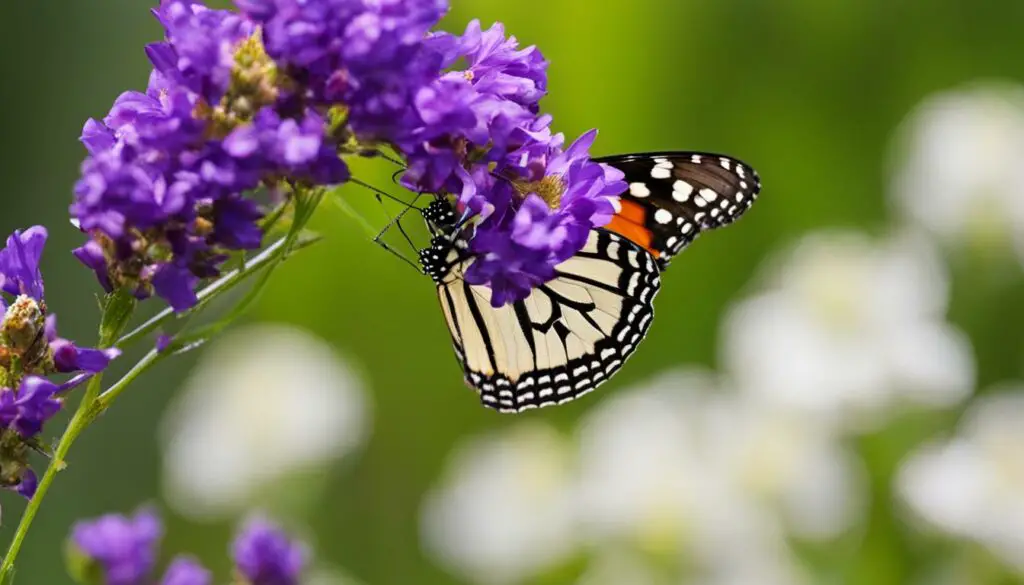
The Process of Caterpillar Transformation
- Step 1: Egg hatching: The journey begins with a caterpillar hatching from an egg, which is usually laid on leaves.
- Step 2: Larva (caterpillar) stage: The newly hatched caterpillar spends its time eating and growing, shedding its skin several times during molting.
- Step 3: Pupa (chrysalis) stage: When the caterpillar reaches its full size, it forms a chrysalis or cocoon. Inside the chrysalis, the caterpillar undergoes metamorphosis, transforming its body into a butterfly.
- Step 4: Adult butterfly emergence: Finally, the fully developed butterfly emerges from the chrysalis, ready to spread its wings and explore the world.
The process of a caterpillar turning into a butterfly is truly extraordinary. From a humble caterpillar to a magnificent butterfly, the transformation is a journey that captivates our imagination and reminds us of the wonders of nature.
The Role of Imaginal Discs
When it comes to the transformation of a caterpillar into a butterfly, imaginal discs play a crucial role. These tiny clusters of cells develop inside the caterpillar’s body before it even hatches from its egg. Each imaginal disc corresponds to a specific adult body part that the butterfly will have, such as wings, antennae, legs, or eyes. These discs remain dormant during the caterpillar stage but become active during metamorphosis.
Once the caterpillar forms a chrysalis, the imaginal discs begin their remarkable work. They use the nutrients present in the caterpillar’s digested tissues, which have turned into a protein-rich soup, to fuel their growth and development. The imaginal discs rapidly divide and differentiate, forming the intricate structures and organs that make up the adult butterfly. This process occurs in a highly organized and coordinated manner, ensuring that each body part develops properly.
| Imaginal Disc | Body Part Developed |
|---|---|
| Wing Discs | Wings |
| Antennal Discs | Antennae |
| Leg Discs | Legs |
| Eye Discs | Eyes |
It is truly fascinating to witness the role of imaginal discs in the metamorphosis of a caterpillar into a butterfly. Without these specialized cells, the butterfly would not be able to develop its unique and intricate adult body parts. The transformational process showcases the incredible complexity and beauty of nature’s design.
Preservation of Certain Caterpillar Features
The process of a caterpillar transforming into a butterfly involves a complete metamorphosis, where most of the caterpillar’s body breaks down and transforms into a butterfly. However, certain features are preserved in the adult butterfly, ensuring coordinated movement and functionality.
Studies have shown that some caterpillar muscles and sections of the nervous system remain intact in the adult butterfly. These preserved features allow for the butterfly to have the ability to fly, walk, and eat. The preserved muscles provide the necessary strength and coordination for the butterfly’s movements, while the preserved nervous system allows for the transmission of signals between different parts of the body.
Furthermore, recent research suggests that moths may retain memories of what they learned during their caterpillar stage. This preservation of memory highlights the interconnectedness between the different stages of the butterfly’s life cycle and adds another layer of complexity to the transformation process.
| Preserved Features in Adult Butterfly | Functions |
|---|---|
| Preserved Muscles | Coordinated movement, flight, walking, and eating |
| Preserved Nervous System | Signal transmission, coordination between body parts |
| Preserved Memory (in moths) | Retention of learned behaviors from the caterpillar stage |
These preserved features in the adult butterfly demonstrate the intricacies of butterfly metamorphosis and the importance of each stage in forming a fully functional and adaptable creature. It showcases the incredible ability of nature to transform and adapt, allowing for the emergence of a beautiful and unique creature from a humble caterpillar.
From Cocoon to Butterfly: A Visual Journey
Witnessing the remarkable transformation of a caterpillar into a butterfly can be quite challenging. However, there are some incredible visual resources available that provide a glimpse into this magical process. One such resource is the website of Michael Cook, where he showcases photos of a Tussah silkmoth that failed to spin a cocoon. The images display the translucent jade wings, antennae, and legs of the pupa, offering a rare view of what is typically hidden. These visuals allow us to appreciate the incredible metamorphosis that a caterpillar undergoes to become a butterfly.
In these captivating images, we can observe the delicate structures of the pupa and witness the intricate development of the butterfly’s body. The photos serve as a visual representation of the process, highlighting the awe-inspiring journey from cocoon to butterfly. They allow us to marvel at the wonders of metamorphosis and gain a deeper understanding of the remarkable changes that occur within the chrysalis.
Delicate Structures Unveiled
One of the most fascinating aspects of the photos is the level of detail they reveal about the pupa’s anatomy. The translucent jade wings, still in development, showcase the intricate patterns and delicate veins that will provide the butterfly with its ability to fly. The images also capture the formation of the antennae and legs, highlighting the complexity of the transformation process. These visuals provide a rare opportunity to appreciate the beauty of a butterfly’s development up close.
An Appreciation for Metamorphosis
By offering a visual journey from cocoon to butterfly, these images inspire a sense of wonder and appreciation for the process of metamorphosis. They remind us of the incredible transformations that can occur in nature and encourage us to embrace change and growth in our own lives. As we gaze upon the delicate structures forming within the chrysalis, we are reminded of the beauty that can emerge from even the most humble beginnings.
| Table: Key Visuals of the Transformation |
|---|
| Translucent jade wings in development |
| Formation of antennae and legs |
| Intricate patterns and delicate veins of the wings |
Butterfly Farms and the Life Cycle
Butterfly farms play a vital role in studying and observing the life cycle of butterflies. These farms partner with institutions like the Florida Museum of Natural History to further our understanding of the caterpillar to butterfly transformation. One of the ways they contribute to this research is by shipping pupae of various butterfly species to be studied.
Once the pupae arrive at the museum, they are carefully unpacked and housed in the museum’s rearing lab. Here, staff members closely monitor their development, recording observations and collecting data. This partnership allows for the close study of the butterfly’s life cycle, providing insights into the transformation process.
By studying butterfly farms, researchers can gain a deeper understanding of the different stages of the butterfly life cycle. From the egg stage to the larva (caterpillar) stage, and finally to the pupa (chrysalis) stage, every step in the transformation process is carefully observed and documented. This information helps us unravel the mysteries of how a caterpillar turns into a butterfly and sheds light on the incredible process of metamorphosis.
In summary, butterfly farms provide invaluable opportunities for researchers and enthusiasts to study the life cycle of butterflies. Through partnerships with institutions and careful monitoring of pupae, these farms contribute to our understanding of the caterpillar to butterfly transformation. By studying the various stages and processes involved, we can gain a deeper appreciation for the intricate beauty of nature’s metamorphosis.
Tracking and Displaying Butterflies in Exhibits
When it comes to showcasing the mesmerizing transformation of a caterpillar into a butterfly, museums and butterfly farms play a crucial role. These institutions carefully track and display butterflies in exhibits, allowing visitors to witness the awe-inspiring process firsthand.
Upon arrival at the museum, the pupae, in their chrysalis stage, are unpacked and individually glued onto large sheets of paper. This mimics the natural hanging position of chrysalides and provides a visually captivating display. Each pupa is meticulously tracked and inventoried to ensure proper care and monitoring throughout its development.
| Stage | Action |
|---|---|
| 1 | Unpacking and gluing pupae onto sheets of paper |
| 2 | Tracking and inventorying each pupa |
| 3 | Ensuring proper care and monitoring |
Once displayed in the museum’s rearing lab, visitors have the opportunity to witness the emergence of adult butterflies. This remarkable display allows for a deeper appreciation of the intricate and beautiful transformations these creatures undergo.
Tracking and displaying butterflies in exhibits not only educates and fascinates visitors but also supports research and conservation efforts. By closely observing the life cycle stages and transformation process, scientists can gain valuable insights into the biology and behavior of butterflies. This, in turn, aids in their protection and preservation in the face of environmental challenges.
The Significance of Stillness in Transformation
When it comes to the transformative journey of a caterpillar turning into a butterfly, there is a profound lesson to be learned about the power of stillness. In our fast-paced world, where constant movement and progress are celebrated, we often overlook the importance of taking a pause and embracing moments of quiet reflection. Yet, it is in these moments of stillness that true transformation can occur.
Just as the caterpillar retreats into its chrysalis, it is essential for us to create space for introspection and self-reflection. In this state of stillness, we have the opportunity to shed the old patterns, beliefs, and limitations that no longer serve us. It is a time to let go of what is no longer working and make room for new growth and possibilities.
Embracing stillness allows for clarity, the shedding of old limitations, and the emergence of a new self.
Stillness is not about doing nothing; it is about creating the conditions for inner transformation. It is about allowing ourselves to be present, fully experiencing the richness of the moment. In this space of stillness, we can tap into our true essence, listen to our inner voice, and gain insights that may have eluded us in the busyness of everyday life.
By embracing stillness, we are cultivating a mindset of patience and trust in the natural unfolding of our own transformation. Just as the caterpillar does not rush its metamorphosis, we too must honor the process and give ourselves the time and space to evolve at our own pace. Embracing stillness allows us to align with our authentic selves and step into the fullness of who we are meant to be.
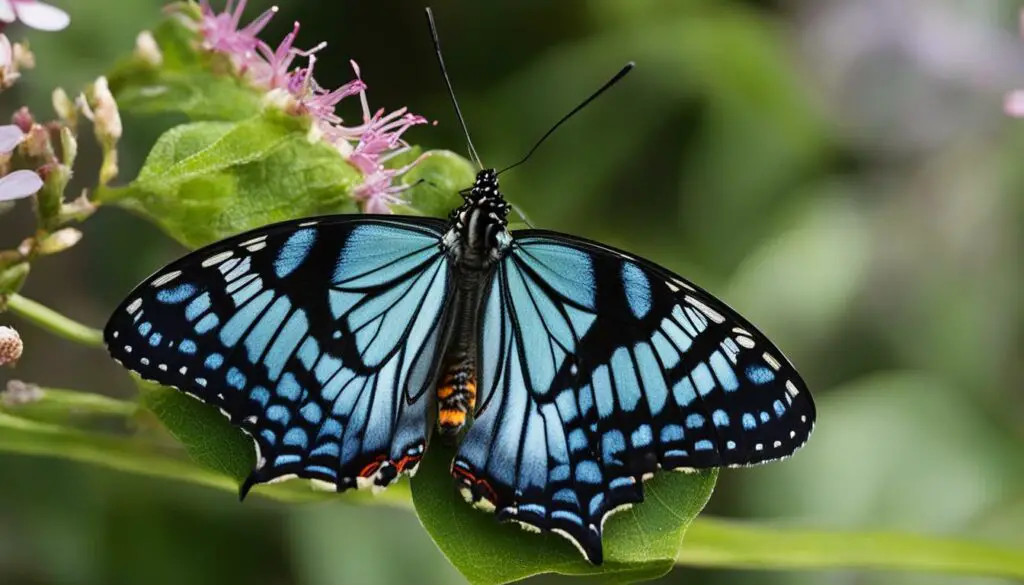
Emulating the Butterfly’s Transformation in Personal Growth
Embarking on a personal growth journey is akin to the remarkable transformation that a caterpillar undergoes to become a butterfly. Just as a caterpillar devours food for growth, we too must consume knowledge and experience to master our craft and develop ourselves. Through learning and expanding our skills, we can lay the foundation for our own transformation.
Similar to the chrysalis stage, personal growth requires moments of stillness and reflection. It is during these times that we can internalize the changes necessary for our transformation. Embracing stillness allows for clarity, the shedding of old limitations, and the emergence of a new self. Just as the caterpillar forms a chrysalis, we must create space within ourselves to reflect, evolve, and grow.
Finally, like the beautiful emergence of a butterfly, we must display our growth and embrace the fragility of our new self as we navigate the world. Just as the butterfly’s wings unfold, we too must spread our metaphorical wings and courageously step into the unknown. By showcasing our growth and embracing our transformation, we inspire others to do the same.
Embracing Personal Growth: Key Takeaways
- Caterpillar-like hunger: Consume knowledge and experiences to fuel personal growth.
- Chrysalis moments: Embrace stillness and reflection to foster internal changes.
- Unfold your wings: Display your growth and embrace your transformation to inspire others.
By emulating the transformative journey of a caterpillar becoming a butterfly, we can unlock incredible personal growth and embrace the changes that shape us into our best selves. Just as the butterfly gracefully navigates the world with its newfound beauty, we too can embark on a journey of self-discovery and transformation.
Table: Comparing Caterpillar Transformation to Personal Growth
| Stages | Caterpillar Transformation | Personal Growth |
|---|---|---|
| Eating and Growth | The caterpillar consumes food and grows rapidly. | We consume knowledge and experiences to fuel our personal growth. |
| Chrysalis Stage | The caterpillar forms a chrysalis for internal transformation. | We embrace stillness and reflection to foster internal changes. |
| Butterfly Emergence | The butterfly emerges with new wings, showcasing its transformation. | We display our growth and embrace our transformation to inspire others. |
Embracing personal growth and transformation is a journey filled with challenges and rewards. Just as the caterpillar transforms into a butterfly, we too can undergo a beautiful metamorphosis and emerge as our best selves. By reflecting on the stages of caterpillar transformation and applying them to our personal growth, we unleash our full potential and inspire others along the way.
The Beauty of Embracing Transformations
Transformation and growth are integral parts of our journey through life. Just as a caterpillar goes through a metamorphosis to become a butterfly, we too experience moments of transformation that shape us into the individuals we are meant to be. Embracing these transformations can lead to a greater sense of self-awareness, personal fulfillment, and a deeper connection with the world around us.
When we embrace transformations, we give ourselves permission to let go of outdated beliefs, behaviors, and patterns that no longer serve us. We open ourselves up to new possibilities and experiences, allowing our true essence to shine through. Like a butterfly emerging from its chrysalis, we can spread our wings and explore the world with a renewed sense of wonder and curiosity.
It is important to remember that transformations often come with challenges and uncertainties. Just as a butterfly faces the struggle of breaking free from its cocoon, we may encounter obstacles along our own transformative journey. However, it is through these challenges that we find strength, resilience, and the capacity to grow. By embracing the process of transformation, we can discover our hidden potential and embark on a path of personal growth and fulfillment.
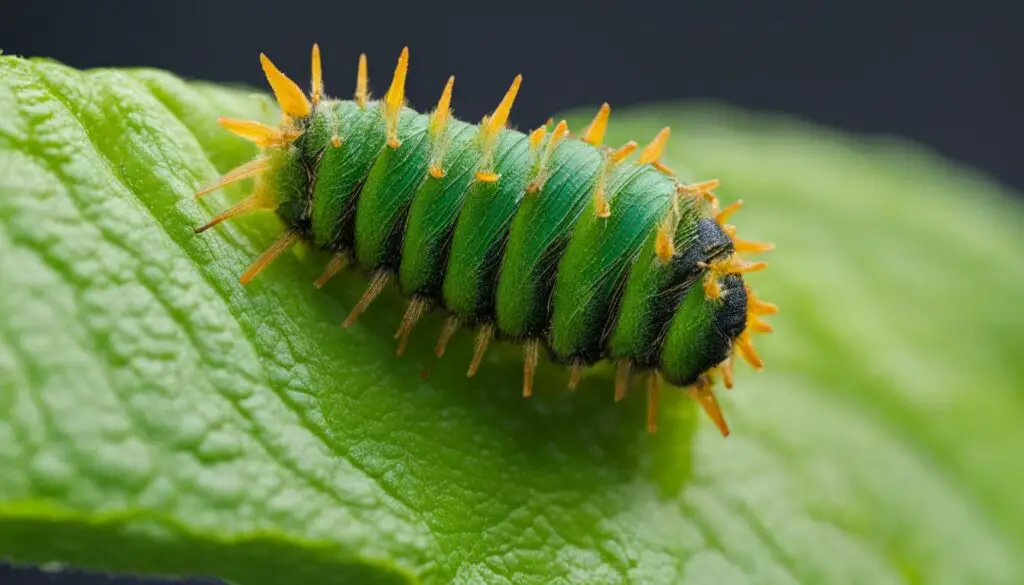
Table: Embracing Transformations
| Benefits of Embracing Transformations | How to Embrace Transformations |
|---|---|
|
|
In conclusion, embracing transformations is a beautiful and transformative journey that allows us to uncover our true potential. Just as a caterpillar transforms into a butterfly, we have the power to grow, evolve, and spread our wings. Let us embrace the beauty of change, celebrate our transformations, and live a life filled with growth, fulfillment, and endless possibilities.
Advice from a Butterfly
As we marvel at the transformation of a caterpillar into a butterfly, we can draw valuable lessons from their journey. Just like a butterfly emerges from a chrysalis, we too have the power to undergo personal transformation and growth. Here are some insights and advice from a butterfly that can guide us on our own transformative journeys.
Let Your True Colors Show
One of the most striking features of a butterfly is its vibrant and diverse array of colors. Similarly, embracing our true selves and expressing our unique qualities is essential for personal growth. Instead of hiding behind masks or conforming to societal expectations, we should let our true colors shine. Authenticity not only allows us to live a more fulfilling life but also inspires others to do the same.
Take Yourself Lightly
Butterflies gracefully dance from flower to flower, effortlessly gliding through the air. They remind us of the importance of taking ourselves lightly and not being weighed down by life’s challenges. By embracing a playful and lighthearted approach, we can navigate through obstacles with ease and find joy in every moment.
Find Sweetness in Life
Butterflies are often associated with sweetness, as they delicately sip nectar from flowers. In our own lives, it’s crucial to seek out the sweetness in every experience. By cultivating gratitude and focusing on the positive aspects of life, we can find joy, even in the midst of difficult times.
Appreciate the Beauty Around You
Butterflies are masters of appreciating the beauty that surrounds them. They flutter amidst flowers, bask in the warm sunlight, and take in the sights and scents of nature. We too can cultivate a sense of wonder and appreciation for the beauty that exists in everyday life. By practicing mindfulness and being present in the moment, we can find joy and inspiration in the simplest of things.
As we embark on our own transformative journeys, let us heed the advice of the butterfly. Embrace your true self, approach life with lightness, savor the sweetness, and appreciate the beauty that surrounds you. Through these practices, we can cultivate personal growth, transform ourselves from within, and unfold into the most vibrant versions of ourselves.
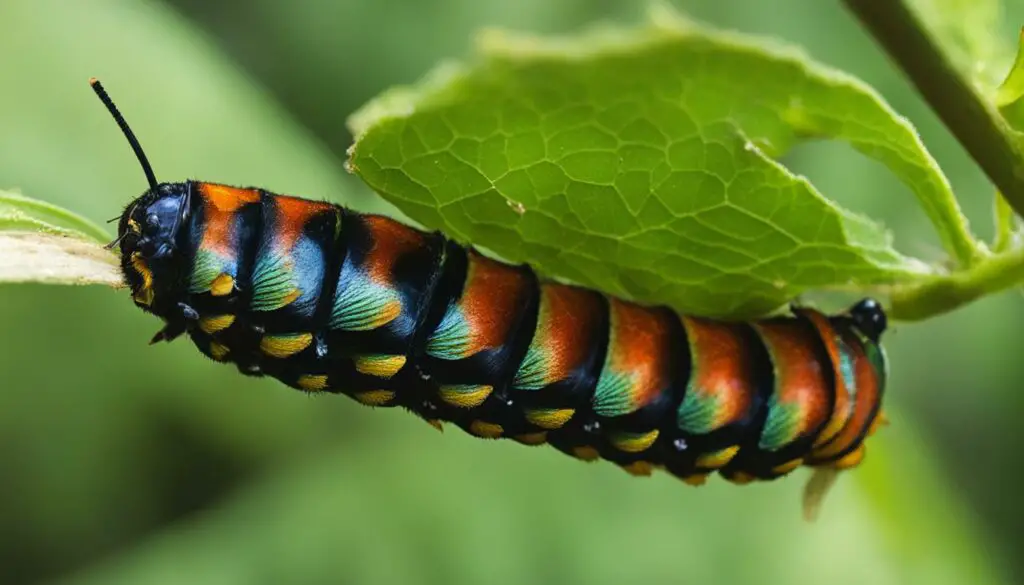
Conclusion
The journey of a caterpillar transforming into a butterfly is a marvelous example of metamorphosis. From the egg to the chrysalis and the emergence as a butterfly, each stage holds its own significance and purpose. It teaches us the importance of consuming knowledge, embracing stillness, and navigating personal transformations.
As we witness the delicate yet powerful butterfly, we are reminded of our own potential for growth. True transformation takes time, patience, and a willingness to embrace change. Just like the butterfly, our own journey of transformation should be approached with courage and grace.
Let us appreciate the beauty and potential within ourselves as we marvel at the beauty of the caterpillar to butterfly transformation. Embracing our unique beauty and continuously striving for personal growth, we can navigate the various stages of life with resilience and gratitude.
FAQ
What are the primary stages of a butterfly’s development?
The primary stages of a butterfly’s development are egg, larva (caterpillar), and pupa (chrysalis).
How does a caterpillar turn into a butterfly?
The process begins with a caterpillar hatching from an egg and growing through molts. It then forms a chrysalis or cocoon, inside which it undergoes a radical transformation.
What are imaginal discs, and what role do they play in the transformation?
Imaginal discs are specific cells that survive inside the chrysalis and develop into the adult body parts of the butterfly. They use the protein-rich soup around them to fuel rapid cell division and form the wings, antennae, legs, eyes, and other features of the butterfly.
Are any features of the caterpillar preserved in the adult butterfly?
Yes, some caterpillar muscles and sections of the nervous system remain intact in the adult butterfly, ensuring coordinated movement and functionality.
Can moths retain memories from their caterpillar stage?
Studies suggest that moths may retain memories of what they learned during their caterpillar stage.
Are there any visual resources available to witness the transformation?
Yes, images of the transformation process, such as the translucent jade wings, antennae, and legs of a pupa, can be observed on Michael Cook’s website.
How do butterfly farms contribute to the study of the butterfly life cycle?
Sustainable butterfly farms partner with institutions to ship pupae of various butterfly species for close study and observation. The pupae are housed in rearing labs, allowing for monitoring and insights into their transformation process.
How are pupae tracked and displayed in butterfly exhibits?
Upon arrival at the museum, pupae are unpacked and individually glued onto large sheets of paper to mimic the natural hanging position of chrysalides. They are then displayed in rearing labs and carefully monitored before being released into exhibits.
What is the significance of stillness in the transformation process?
The chrysalis stage represents a period of stillness and self-reflection, allowing for internal changes necessary for personal transformation.
How can we emulate the butterfly’s transformation in personal growth?
Emulating the process involves consuming knowledge and experience for growth, embracing stillness and reflection, and displaying our growth and embracing our unique selves as we navigate the world.
What can we learn from embracing transformations?
Embracing transformations allows us to let our true colors show, find sweetness in life, appreciate the beauty around us, and give ourselves the care and attention we deserve.
What advice does a butterfly offer for transformation and growth?
The butterfly encourages us to embrace our own transformation and growth with courage and grace, showcasing our unique beauty and recognizing that transformation is a continuous process.

